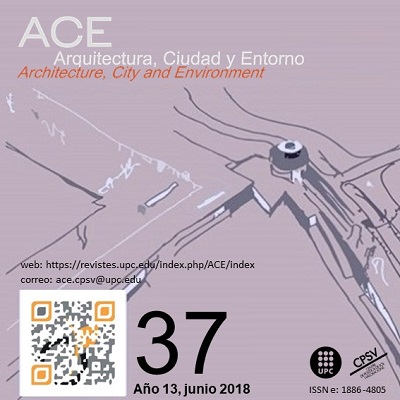Antonio Gaudí, the forerunner of sustainability and biomimicry in architecture, 100 years in advance
DOI:
https://doi.org/10.5821/ace.13.37.5348Keywords:
Bioclimatic architecture, ecology, environmental impactAbstract
Purpose
Sustainability in architecture is one of the major challenges of the twenty-first century. In biomimetic architecture, nature is the model of choice in the quest for sustainability; because it shows us the most environmentally friendly and sustainable models developed over 3.8 billion years of evolution.
Antonio Gaudí said that: "The architect of the future will build imitating nature, for it is the most rational, long-lasting, and economical of all methods". Gaudí, taking nature as his model, optimises his buildings bioclimatically; he widely uses bricks and tiles ―the cheapest materials at the time―, he uses local stone, and he takes advantage of waste materials or debris, and optimises the structural design of his buildings.
Methodology
To assess Gaudís’ contributions to sustainability in architecture today, his most significant works have been studied, and bibliographical records have been made of the systems developed by Gaudí to enhance the performance of his buildings in the three fields of sustainability: environmental, economic, and social.
Conclusions
Gaudí was a great forerunner of sustainability and biomimicry in architecture, and teaches us that buildings conceived as "machines for living" ―by the great architect Le Corbusier― can evolve and become "ecosystems in which to live".
Originality
Gaudís’ great artistic and creative talent has been assessed together with his innovative architectural style and his technical and structural innovations; however, his role as a forerunner of sustainability in architecture has not been studied.
Downloads
Published
Issue
Section
License
| INTELECTUAL PROTECTION CRITERIA |
At this moment, it is count with the "Oficina Española de Patentes y Marcas", while global protection it is being processed by the World Intelectual Property Organization (OMPI/WIPO). Nevertheless the International Standard Serial Number Office (ISSN) has given the following numbers ISSN: 1886-4805 (electronic version) and 1887-7052 (paper version). All articles will be peer reviewed, using double blind reviewing. |
| COPYRIGHT |
The article contents and their comments are authors exclusive liability, and do not reflect necessarily the journal editor commitee's opinion. All ACE published works are subject to the following licence CC BY-NC-ND 3.0 ES http://creativecommons.org/licenses/by-nc-nd/3.0/es/ It implies that authors do not hold nor retain the copyright without restrictions but only those included in the licence. |


































